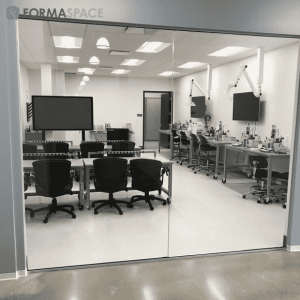Working Remotely in a Lab Environment

Formaspace builds custom laboratory furniture at our factory headquarters in Austin, Texas. Shown above is a custom-designed modular laboratory with workbenches built to serve as the processing station for lab samples.
Covid-19 has opened up new opportunities for online research - find out how you can take advantage of remote work in a laboratory environment.
But does that paint a realistic picture of today’s research laboratory environments?
Most lab professionals would say no – today’s reality is quite different.
In the last two decades, more and more laboratory research is taking place outside of traditional wet lab settings, thanks to rapid advances in computer software and big data analysis.
What Lab Managers Need To Know About Managing A Remote Lab Setup
During the height of the coronavirus pandemic lockdown in 2020, many lab managers suddenly found they needed to create new policies and procedures to allow those normally working in so-called “dry labs” to transition to working from home (WFM).
Of course, many of these lab managers were not starting from scratch – as many commercial and academic labs already had long-standing (often informal) policies that allowed employees to work from home one or more days a week.
As you might imagine, many lab workers with long-term experience working from home found the transition to full-time work outside the lab to be a fairly smooth one.
However, just as in the case of office managers, lab managers also found it necessary to provide significant additional support to those workers who had little or no experience establishing a functional home office.
These workers often required coaching to overcome common technology challenges, e.g. connecting to a secure VPN to access remote files; learning best practices for conducting meetings using videoconferencing systems such as Zoom; or using groupware tools, such as Slack, effectively.
Lab managers also had to confront how to develop and maintain a cohesive and productive team, despite the fact they now rarely met face-to-face. They discovered that many of their traditional “people management” practices, such as making daily rounds of the laboratory to find out what each person is working on, didn’t translate well in an online, virtual work environment.
Much to their chagrin, the act of constantly checking in with employees “to find out how they are doing” often came across as an annoying or even aggressive micromanager.
But over these past months of the pandemic, lab managers and HR departments have been able to adapt by creating new policies and procedures to formalize what had once been an informal practice of allowing “dry lab” workers to transition to working from home full time.
But what about “wet lab” workers who work with samples or those lab researchers who need to operate lab equipment?
How can these workers accomplish some of their tasks while working from home?
Take Inspiration From Remote Labs Used In Education Settings
Much of today’s inspiration for creating a fully remote laboratory operation comes from innovations first pioneered in the field of science education.
Long before the arrival of the pandemic, science education professionals around the world had been investigating ways to create “remote control” laboratories – to allow students to conduct experiments, take measurements, or otherwise learn scientific principles using remote sensing and control devices.
One such early adopter of remote lab technology is Professor Yau-Yuen Yeung of the Education University of Hong Kong, whose lab (shown in the above video) pioneered experiments in implementing highly customized controls that would allow students to conduct laboratory experiments remotely.
A more recent example is the Biology Cloud Lab, created at Stanford University by the collaboration of a bioengineering professor, Ingmar Riedel-Kruse, and a professor of education, Paulo Blikstein.
The Biology Cloud Lab uses cell cultures designed to be long-lasting and stable, allowing numerous students to conduct remote experiments on the cultures over a multi-week period. So far, the lab has evaluated the experiences of students at the college-level biophysics class level as well as experiments suitable for middle-schoolers.
“We are doing to biology what Seymour Papert did to computer programming in the 1970s with the Logo language,” Blikstein said. “The Biology Cloud Lab makes previously impossible activities easy and accessible to kids – and maybe also to professional scientists in the future.”
Conducting Remote Lab Equipment Monitoring
What can we learn from these pioneering efforts of “remote labs,” and how can we apply them to commercial and postsecondary academic laboratories?
The first thing is to break down the problem into two broad categories:
1. Conducting Remote Lab Equipment Monitoring
2. Managing Remote Lab Experiments
Let’s address the first category, lab equipment monitoring, as it’s a far simpler use case.
The reason for this should be clear, given that so much of today’s laboratory equipment is fully automated and does not need hands-on attention.
And increasingly, many of the newest lab test equipment products offer optional remote access, often via smartphone, that allows lab workers to monitor the progress of an experiment and download the data results remotely.
Read more...
Julia Solodovnikova
Formaspace
+1 800-251-1505
email us here
Visit us on social media:
Facebook
Twitter
LinkedIn
Legal Disclaimer:
EIN Presswire provides this news content "as is" without warranty of any kind. We do not accept any responsibility or liability for the accuracy, content, images, videos, licenses, completeness, legality, or reliability of the information contained in this article. If you have any complaints or copyright issues related to this article, kindly contact the author above.


